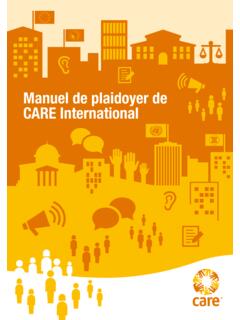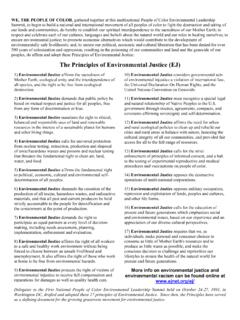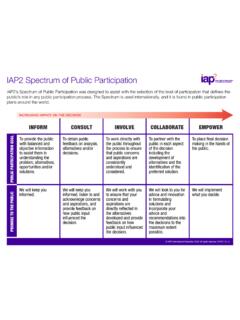Transcription of CARE International Gender Equality Policy June 2018
1 Final For Submission June 2018 1 CARE International Gender Equality Policy June 2018 1. Introduction CARE s vision is to seek a world of hope, tolerance and social justice; where poverty has been overcome and people live in dignity and security. CARE puts Gender Equality in the centre because we know that we cannot overcome poverty and social injustice until all people have equal rights and opportunities. We recognize that power relations between genders and ages are unequal, and that we must challenge patriarchy and promote Gender Equality to achieve social justice. Through this Policy , CARE commits to ensuring that Gender Equality is fully incorporated in all our work both as a universal human right and an end in itself, as well as a means to overcome poverty and social injustice more effectively. Working with others, CARE seeks to promote equal realization of dignity and human rights for all genders and ages, and the elimination of poverty and injustice.
2 This Policy will be implemented in the context of local legal environments. CARE recognizes that Gender is not binary, and that terms and definitions related to Gender and sexuality are diverse and continue to evolve. To facilitate ease of reading within this Policy we refer to all genders and ages throughout. This demonstrates our recognition of and ability to work with adults and children and individuals of all sexual orientations, Gender identities and/or Gender expressions. We recognize that rigid Gender norms limit people of all genders and sexual orientations by creating and reinforcing assumptions and systems of privilege (sometimes codified in laws and policies), about their recognition in society and the range of roles and opportunities open to them. These not only limit individuals who identify as girls, boys, women and men as well as identities beyond the binary, but also individuals whose sexual orientations do not conform with dominant norms and expectations of heterosexuality.
3 While rigid Gender norms can limit all of us, CARE also recognizes that Gender norms and hierarchies are constructed by people and systemically privilege some groups over others. Throughout this Policy when reference is made to all genders and ages this includes (cisgender and transgender) women and girls, men and boys as well as people who identify beyond the binary; and people of all sexual orientations. 2. Purpose This CARE International Policy represents CARE s1 commitment to take a cohesive and coordinated approach to Gender Equality . The Policy defines CARE s explicit intention to support Gender Equality and the principles expressed in International agreements2. The Policy includes three core principles and commitments against which all parts of CARE International will be held accountable3. These are consistent with other organisational and programmatic standards4.
4 The purpose of the Policy is to: Define and communicate clear commitments and consistent messages within CARE and with others 1 Throughout this Policy the term CARE is used to denote every CARE entity including Members, Affiliates and Candidates Transitioning to Membership (Candidates) of the Confederation and regional, sub-regional and country offices 2 Relevant International Agreements include: Convention on the Political Rights of Women (1954); Convention to the Consent of Marriage, Minimum Age of Marriage, and Registration of Marriages (1964); Declaration on the Protection of Women and Children in Emergency and Armed Conflict (1974); Convention on the Elimination of All Forms of Discrimination Against Women (CEDAW) (1979); Declaration of the Elimination of Violence against Women (1993); Beijing Declaration and Platform for Action (PFA) (1995); CEDAW's Optional Protocol; Maputo Protocol Protocol to the African Charter on human and Peoples Rights on the Rights of Women in Africa (2003); Convention on preventing and combating violence against women and domestic violence (Istanbul Convention) (2014) 3 See Annex 2 for further information on accountability and reporting 4 This Policy is complementary to the CARE s vision, mission and core values and CARE International Policy on Protection from Sexual Exploitation and Abuse and Child Protection; the standards herein are consistent with those laid out in the CARE Gender Equality and Women s Voice Guidance and Life Free from Violence Global Strategy.
5 Final For Submission June 2018 2 Continue to strengthen efforts to promote Gender Equality in our organisation, increasing CARE s integrity and credibility amongst donors, partners and allies as a leader in the Gender Equality space, in both programming and advocacy Establish commitments for our development and humanitarian programming and our organisation Enable us to work as a confederation and with others building on each other strengths, experience and lessons learned 3. Core Principles CARE is a rights based organisation. Gender Equality is an explicit internationally recognized human right and CARE seeks to promote equal realization of dignity and human rights and the elimination of poverty and injustice for all genders and ages. Our commitments are founded on the human Rights Framework and globally agreed principles5, such as Equality and non-discrimination.
6 They based on International law and regional standards6, in particular the Convention on the Elimination of all forms of Discrimination Against Women (CEDAW), as well as relevant soft laws7 and the global ambitions set out in the Sustainable Development Goals (SDGs)8. CARE recognises that issues of Gender inequality intersect with other forms of oppression based on unequal power relations, such as ableism, racism, caste and ethnic discrimination, ageism, sexual orientation and homophobia, religious discrimination, classism, colonial history among others. CARE works with marginalized women and their allies to address structural barriers to the realization of women s rights and Gender Equality ; social justice, peace, wellbeing and a life free from violence. 4. What we need to do to implement the Gender Equality Policy Commitments In order to enact these principles, CARE will fulfil the following 12 commitments and ensure that they are monitored, evaluated and reported on as part of CARE s responsibility of transparency and accountability.
7 1. Incorporate participatory Gender and power analysis9 and data disaggregated by sex, age, and other relevant diversity factors10 to inform actions across the programme/project cycle. 2. Articulate how programming works across all three domains of the Gender Equality Framework11, and apply and learn from the Gender Marker12 at every stage of the project or programme cycle to improve our Gender transformative potential. 3. Engage men and boys13 in support of Gender Equality and women s empowerment when in line with programming and/or organizational objectives. 5 human Rights Principles include: Universality and Inalienability, Indivisibility, Participation and Inclusion, Accountability and Rule of Law, Transparency, and Equality and Non-Discrimination 6 See footnote 2.
8 7 Soft laws are non-binding International standards such as resolutions in the human Rights Council or General Assembly, General Comments by the CRC or CEDAW Committees, etc. 8 Refer to Annex 1, Rationale, for further information. 9 There are a variety of tools that can be used to do Gender and power analysis; they are not necessarily separate processes, however any situational analysis must include an analysis of Gender and power. In humanitarian settings a rapid Gender analysis is required. 10 These may include: race, ethnicity, sexual orientation and identity, age, class, caste, religion, physical and mental ability 11 The three domains of the Gender Equality Framework are Agency, Relations and Structure, refer to the Gender Equality and Women s Voice Guidance Note, CARE, April 2018 12 Gender Marker, CARE 2017 + Gender +Marker+new+improved+version%21+% 28 June+2016%29 13 Engaging Men and Boys, CARE Final For Submission June 2018 3 4.
9 Identify potential programming risks throughout the program/project cycle and take steps to do no harm and mitigate unintended consequences of backlash and Gender -based violence, regardless of sectoral focus, especially in fragile and conflict contexts14. 5. Form partnerships with women s rights15 and/or LGBTIQ16 organisations and movements to collaborate in the achievement of shared goals and elevate the voice of marginalised people; and engage key stakeholders in the struggle for Gender Equality including other civil society, government, private sector, public and private donors. 6. Ensure evaluations17 and reviews do no harm, are participatory and assess progress towards Gender Equality outcomes18. Ensure that they document best practices and challenges, and create mechanisms for cross-learning within communities, within CARE and with partners.
10 7. Ensure all our human resources policies and practices are developed with a Gender lens. Report on Gender and diversity balance in staffing and governance structures along with average pay levels. Implement targeted strategies to redress any evidence of Gender inequality in Gender and diversity balance and pay levels. 8. Recruit and retain staff with a commitment to Gender Equality ; build staff and partner capacity and skills in Gender Equality and diversity, and ensure all annual operating plans, job descriptions and performance plans reflect CARE s commitment to Gender Equality . 9. Regularly report to programme participants, donors and the public on progress on Gender Equality in CARE s work. 10. Take all measures to prevent and respond to all forms of sexual harassment and violence, and sexual exploitation and abuse of children and vulnerable adults, promote staff awareness and training, and effective systems for reporting and monitoring.











